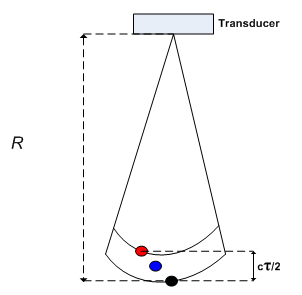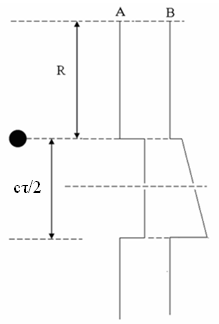Principles of TVG range correction and Sv data
The calculation of range R of a target using the received echo time is discussed in Principles of TVG range correction for single targets. The concepts that underlie the range calculation are useful in dealing with the average range of random targets in a sampled volume1 with a volume backscattering strength of Sv.
Randomly distributed targets in the beam

Figure 1: A sampled volume.
The black target is at range R meters, the red target is at R - cτ/2 and the blue target is somewhere in between.
Where:
|
R
|
= | Range (m) of the black target. |
|
c
|
= | Speed of sound (m/s) in the medium. |
|
τ
|
= | Duration (s) of the transmitted pulse. |
For a sampled volume, an echo is measured at range R meters. Where does the echo measured at R originate?
Targets with ranges between (R – cτ/2) and R will contribute to the echo at R meters. Targets outside this range interval do not contribute to the echo.
Where targets are randomly distributed in the beam (either within a ping or averaged over many pings), the average range of the targets that contribute to the echo at R meters, is (R – cτ/4).
Therefore the TVG for a sample at R meters should be calculated with a range of R - cτ /4.
When the receiver delay is not zero then the correction is R - cτ /4 - δ.
A calibration sphere

Figure 2: A calibration sphere (black dot) at range R. Pulse A models an ideal echo. Pulse B models a non-ideal echo.
The echo envelope is cτ/2 wide in range space.
In Figure 2. the single target is a calibration sphere that is on axis at a range of R meters. What is the correct range to apply the TVG for each sample in the echo envelope?
The TVG for each sample of the target sphere should have the same Sv independent of range. The correct TVG would use the range R for each sample in the echo envelope of a single target, however this is not practical. In practice the TVG compensation is applied at a range of (Ri – cτ/4 - δ ).
For an on axis single target:
- Samples with a range less than the center of the echo will be under compensated.
- Samples with range greater than the center of the echo will be over compensated.
Ignoring second order effects of the non-linear TVG function, the average TVG compensation applied to the single target will be correct.
This is the same solution as for randomly distributed targets.
Echoview and Sv variables
Echoview implements the equation for Sv that is supplied by the echosounder manufacturer. Refer to the topic Is my Sv data affected? for information on the nature of TVG range correction for your data.
1Simmonds and MacLennan, Fisheries Acoustics Theory and Practice (2005) page 47
Return to TVG range correction overview
See also